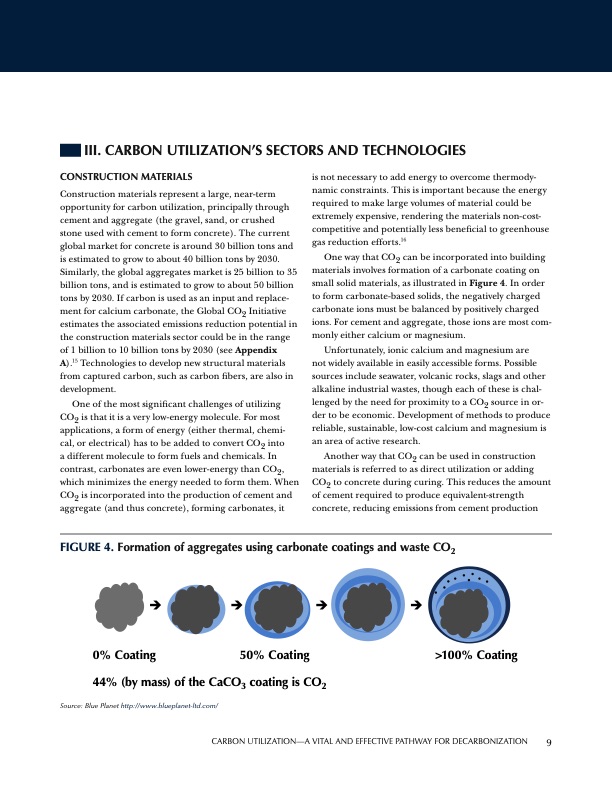
PDF Publication Title:
Text from PDF Page: 017
III. CARBON UTILIZATION’S SECTORS AND TECHNOLOGIES CONSTRUCTION MATERIALS Construction materials represent a large, near-term opportunity for carbon utilization, principally through cement and aggregate (the gravel, sand, or crushed stone used with cement to form concrete). The current global market for concrete is around 30 billion tons and is estimated to grow to about 40 billion tons by 2030. Similarly, the global aggregates market is 25 billion to 35 billion tons, and is estimated to grow to about 50 billion tons by 2030. If carbon is used as an input and replace- ment for calcium carbonate, the Global CO2 Initiative estimates the associated emissions reduction potential in the construction materials sector could be in the range of 1 billion to 10 billion tons by 2030 (see Appendix A).15 Technologies to develop new structural materials from captured carbon, such as carbon fibers, are also in development. One of the most significant challenges of utilizing CO2 is that it is a very low-energy molecule. For most applications, a form of energy (either thermal, chemi- cal, or electrical) has to be added to convert CO2 into a different molecule to form fuels and chemicals. In contrast, carbonates are even lower-energy than CO2, which minimizes the energy needed to form them. When CO2 is incorporated into the production of cement and aggregate (and thus concrete), forming carbonates, it is not necessary to add energy to overcome thermody- namic constraints. This is important because the energy required to make large volumes of material could be extremely expensive, rendering the materials non-cost- competitive and potentially less beneficial to greenhouse gas reduction efforts.16 One way that CO2 can be incorporated into building materials involves formation of a carbonate coating on small solid materials, as illustrated in Figure 4. In order to form carbonate-based solids, the negatively charged carbonate ions must be balanced by positively charged ions. For cement and aggregate, those ions are most com- monly either calcium or magnesium. Unfortunately, ionic calcium and magnesium are not widely available in easily accessible forms. Possible sources include seawater, volcanic rocks, slags and other alkaline industrial wastes, though each of these is chal- lenged by the need for proximity to a CO2 source in or- der to be economic. Development of methods to produce reliable, sustainable, low-cost calcium and magnesium is an area of active research. Another way that CO2 can be used in construction materials is referred to as direct utilization or adding CO2 to concrete during curing. This reduces the amount of cement required to produce equivalent-strength concrete, reducing emissions from cement production FIGURE 4. Formation of aggregates using carbonate coatings and waste CO2 0% Coating 50% Coating >100% Coating 44% (by mass) of the CaCO3 coating is CO2 Source: Blue Planet http://www.blueplanet-ltd.com/ CARBON UTILIZATION—A VITAL AND EFFECTIVE PATHWAY FOR DECARBONIZATION 9PDF Image | Carbon Utilization

PDF Search Title:
Carbon UtilizationOriginal File Name Searched:
carbon-utilization-a-vital-and-effective-pathway-for-decarbonization.pdfDIY PDF Search: Google It | Yahoo | Bing
NFT (Non Fungible Token): Buy our tech, design, development or system NFT and become part of our tech NFT network... More Info
IT XR Project Redstone NFT Available for Sale: NFT for high tech turbine design with one part 3D printed counter-rotating energy turbine. Be part of the future with this NFT. Can be bought and sold but only one design NFT exists. Royalties go to the developer (Infinity) to keep enhancing design and applications... More Info
Infinity Turbine IT XR Project Redstone Design: NFT for sale... NFT for high tech turbine design with one part 3D printed counter-rotating energy turbine. Includes all rights to this turbine design, including license for Fluid Handling Block I and II for the turbine assembly and housing. The NFT includes the blueprints (cad/cam), revenue streams, and all future development of the IT XR Project Redstone... More Info
Infinity Turbine ROT Radial Outflow Turbine 24 Design and Worldwide Rights: NFT for sale... NFT for the ROT 24 energy turbine. Be part of the future with this NFT. This design can be bought and sold but only one design NFT exists. You may manufacture the unit, or get the revenues from its sale from Infinity Turbine. Royalties go to the developer (Infinity) to keep enhancing design and applications... More Info
Infinity Supercritical CO2 10 Liter Extractor Design and Worldwide Rights: The Infinity Supercritical 10L CO2 extractor is for botanical oil extraction, which is rich in terpenes and can produce shelf ready full spectrum oil. With over 5 years of development, this industry leader mature extractor machine has been sold since 2015 and is part of many profitable businesses. The process can also be used for electrowinning, e-waste recycling, and lithium battery recycling, gold mining electronic wastes, precious metals. CO2 can also be used in a reverse fuel cell with nafion to make a gas-to-liquids fuel, such as methanol, ethanol and butanol or ethylene. Supercritical CO2 has also been used for treating nafion to make it more effective catalyst. This NFT is for the purchase of worldwide rights which includes the design. More Info
NFT (Non Fungible Token): Buy our tech, design, development or system NFT and become part of our tech NFT network... More Info
Infinity Turbine Products: Special for this month, any plans are $10,000 for complete Cad/Cam blueprints. License is for one build. Try before you buy a production license. May pay by Bitcoin or other Crypto. Products Page... More Info
| CONTACT TEL: 608-238-6001 Email: greg@infinityturbine.com | RSS | AMP |